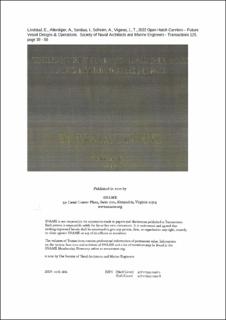| dc.contributor.author | Lindstad, Elizabeth | |
| dc.contributor.author | Alterskjær, Sverre Anders | |
| dc.contributor.author | Sandaas, Inge | |
| dc.contributor.author | Solheim, Astrid Vamråk | |
| dc.contributor.author | Vigsnes, Joakim Tveiten | |
| dc.date.accessioned | 2023-05-21T20:24:31Z | |
| dc.date.available | 2023-05-21T20:24:31Z | |
| dc.date.created | 2023-05-01T15:54:43Z | |
| dc.date.issued | 2022 | |
| dc.identifier.citation | Transactions - Society of Naval Architects and Marine Engineers. 2022, 125 (ISBN 978-1-7923-1228-1), 39-56. | en_US |
| dc.identifier.issn | 0081-1661 | |
| dc.identifier.uri | https://hdl.handle.net/11250/3068402 | |
| dc.description.abstract | The development of Open hatch carriers (OHC) dates back to the early 1960s linked to transport of newsprint from the paper mills along the coast of British Columbia (Canada) to the news-printers in San Francisco and Los Angles (USA). Prior to that, conventional general cargo ships, tween-deck liners and trampers transported newsprint and lumber (timber). The present OHC fleet transport a wide range of commodities in addition to the initial newsprint, i.e. timber (lumber), fertilizer (both as bulk and in bags), minor bulk, containers, project cargoes and even road units on multi decks. This implies that the present OHC fleet are competing with dry bulkers for typical dry bulk cargoes, and with container vessels and Ro-Ro's for cargo types, which requires more careful handling. The paper presents an overview of the historic development of transport efficiencies from the steam ships used in newsprint and timber trades in the early 1900 up to the latest generation of OHC's. Followed by a parametric feasibility study focusing on identifying cost and improvement potentials for new alternative designs versus the present. The results indicates that alternative combinations of main measurements to enable lower block coefficients reduces fuel consumption and greenhouse gas emissions (GHG) per freight unit transported. Moreover, these designs might increase the competitiveness of Open Hatch vessels versus their competitors, i.e. dry-bulk, container and Ro-Ro. | en_US |
| dc.description.abstract | Open Hatch Carriers - Future Vessel Designs & Operations | en_US |
| dc.language.iso | eng | en_US |
| dc.title | Open Hatch Carriers - Future Vessel Designs & Operations | en_US |
| dc.title.alternative | Open Hatch Carriers - Future Vessel Designs & Operations | en_US |
| dc.type | Journal article | en_US |
| dc.type | Peer reviewed | en_US |
| dc.description.version | publishedVersion | en_US |
| dc.source.pagenumber | 39-56 | en_US |
| dc.source.volume | 125 | en_US |
| dc.source.journal | Transactions - Society of Naval Architects and Marine Engineers | en_US |
| dc.source.issue | ISBN 978-1-7923-1228-1 | en_US |
| dc.identifier.cristin | 2144551 | |
| dc.relation.project | Norges forskningsråd: 237917 | en_US |
| cristin.ispublished | true | |
| cristin.fulltext | original | |
| cristin.qualitycode | 1 | |
